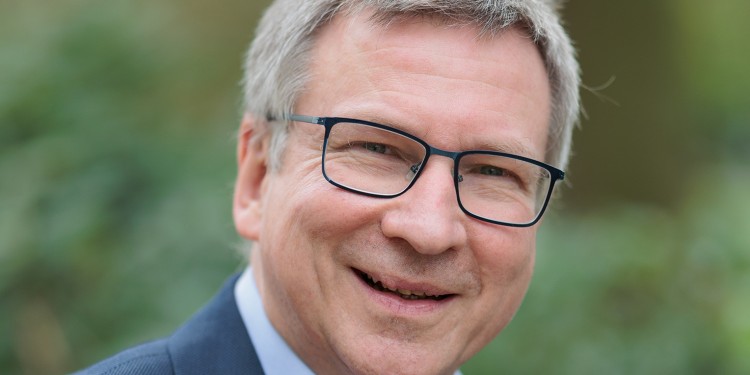
“Scientific curiosity is what drives me”
Christian Weinheimer sees his job as a university professor as having something of the football coach. Just as such a coach gets the best out of his team, so Weinheimer supports and motivates the young people in his team. Of course, the Weinheimer working group doesn’t aim at top-level sporting achievements – but it does seek to be among the best in research worldwide. “I’m very proud of my team,” says the astroparticle physicist. So far, the group has produced 33 doctorates, and many of them have embarked on an academic career. Some are now professors themselves, heading a team of their own.
While he was still an undergraduate and then a PhD student, Christian Weinheimer was already on the trail of the neutrino mass. As one of the founding fathers, he has played a key role for over 20 years now in the Karlsruhe Tritium Neutrino Experiment (KATRIN) at the Karlsruhe Institute of Technology. This large-scale international project is investigating what mass neutrinos have. The only thing known so far is that this mass is extremely small.
The second big research topic he is working on involves the search for dark matter. The Münster group is a highly visible part of an international collaboration. In the large-scale experiment entitled “XENONnT”, experts at the Italian national laboratory Gran Sasso, deep inside a mountain in the Abruzzo region, are looking for particles of dark matter. “We know that dark matter constitutes around 80% of all matter in the universe – but we don’t know what it consists of,” says Weinheimer. His favourite particles, the neutrinos, represent just a small part of this matter, but the physicists suspect that the main part consists of a new sort of particle.
Both experiments are shifting the boundaries of knowledge, using technology which cannot be bought anywhere. Anyone who wants to write his degree thesis under Christian Weinheimer therefore needs to be prepared to travel new paths and to tinker. Some of the equipment and technology used is “made in Münster” – pioneering work which represents a world record or two, designed and constructed at the Institute of Nuclear Physics. However, not only the equipment but also various methods of analysis and measurement developed by the Münster team make a significant improvement to the sensitivity of the experiments – and this is something that Weinheimer is particularly proud of. Some of these methods are today also used in other experiments, for example at the GSI/FAIR research centre in Darmstadt and in the development of new detectors in medical technology.
“Scientific curiosity is what drives me, and creativity is my recipe,” says Weinheimer, who was appointed to a professorship at Münster after having previously been at Mainz University, at CERN, and at Bonn University. For the XENONnT experiment his team designed and built two cryogenic distillation devices which can remove traces of the noble gases crypton and radon from the gas xenon. Certain radioactive isotopes in these gases trigger signals which can seriously interfere with the measurements. For the follow-up experiment, the team aims to make a further clear improvement to reducing the noble gas isotope as well as developing methods enabling the remaining extremely low traces of the gases to be measured. The aim is to achieve a concentration of just one radon atom among 100 mol of xenon – which is far beyond what is considered to be chemically pure and, by today’s standards, impossible. For this, Weinheimer was awarded an ERC Advanced Grant by the European Research Council. One of his latest projects is an electron detector, microstructured with the help of colleagues from the field of nanophysics, for the purpose of removing an interference signal in the KATRIN experiment caused by radon disintegration.
Christian Weinheimer majored in mathematics, until he later switched to physics, which had been his secondary subject. At that time it was all about quantum mechanics – which is something that still fascinates him today. However, his love of mathematics has remained with him. “The ability to think analytically and describe complex systems mathematically helps me enormously as an experimental physicist,” says the father of three grown-up children.
Besides research, teaching, international committee work and other tasks, Weinheimer – who originally wanted to become a teacher like his parents – sometimes slips into a further role: together with his wife he does voluntary work in a Protestant church parish in Münster. “I primarily look after technical things, and sometimes I’m a sort of caretaker,” he says. “What I can manage are DIY skills or understanding technical things – or simply carting tables around. That keeps my feet on the ground – at times like that I’m not the professor for once.”
Christian values are important to him, and he is well able to apply them to his work. It is a question, he says, of assuming social responsibility, of being a multiplier, and of strengthening students and doctoral researchers during a decisive part of their life’s journey … and, besides all this, it’s all about prising one or two secrets from nature.
Author: Christina Hoppenbrock
This article is from the university newspaper wissen|leben No. 1, 31 January 2024.
